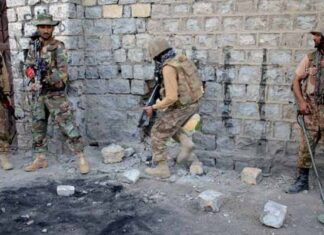PAKISTAN’S DIGITAL SHIELD IN THE ERA OF INVISIBLE WAR: The great wars of the past were fought with tanks, jets, and artillery. Wars today- and tomorrow- are fought in mute silence, on glowing screens, and invisible networks. Here, Pakistan is not an unknowing spectator as a line or two of malicious code can kill the economy or incapacitate the command systems of a country. It is indeed a state that understands the stakes, acknowledges the existential dangers, and is diligently building a cyber shield capable of safeguarding sovereignty against the most elite of the adversaries.
There is a distinction between a tale of catching up for Pakistan in cyber evolution and a tale of smart adaptation. Whereas countries boast about huge cyber budgets, Pakistan knows how to achieve the strategic effect with precise tools and asymmetric capabilities. In this region, the digital battlefield is as active as the Line of Control; hence, Pakistan’s resolve to defend its networks now, counter hostile narratives, and prepare for future cyber offensives is not just commendable but essential for its survival and rise as an emerging digital power in South Asia.
THE EVOLUTION OF CYBER POWER IN PAKISTAN: In recent years, with the explosion of cyberattacks on an international level— from financial scams to shutdowns of power grids— it became necessary for countries to rethink their overall strategy toward cyber warfare.
Cyber preparedness entered the national security agenda in Pakistan by the mid-2010s. This was not just about imitating superpower doctrine; rather it was placing it into a framework that matched Pakistan’s threat environment and with its resource realities. The transition was away from pure defensive posturing toward developing offensive capabilities for use against imminent threats.
The approach was similar to the doctrine of “strategic depth” in terms of conventional warfare- but it was actually in cyberspace. Pakistan would include efficiency in the ability to operate in enemy networks, locate intelligence, and disrupt hostile systems, rather than perimeter defence.
OFFENSIVE AND DEFENSIVE CAPABILITIES: Defensive cyber capabilities of Pakistan have transformed enormously over the last decade. There are secure, air-gapped military networks that prevent any remote infiltration; all sensitive data is secured by sophisticated firewalls and intrusion detection systems that are layered. Moreover, in real time, the Security Operations Centres (SOCs) can assure that any anomaly will be detected and neutralized before any major damage is caused.
To use an offensive metaphor, it is demonstrated that Pakistan is not only able to defend but also attack. It has such systems that can conduct a targeted disruption to enemy communication; penetrate secured networks for intelligence-gathering purposes; and conduct tactical actions in information warfare to counteract hostile propaganda. Like special forces in the traditional forms of combat, these attack cyber teams operate quietly, strike precisely, and disappear without leaving a digital fingerprint.
CYBER FORCES ORGANIZATIONAL STRUCTURE IN PAKISTAN: The cybersecurity architecture of Pakistan is not a single monolithic body but a coordinated ecosystem. Each strategic-level command at the top aligns cyber policy with national security objectives. While each arm maintains its own specific cyber unit, whose responsibilities include protecting branch-specific systems and supporting field operations.
The online combat potential of the civilian sector lies within agencies such as the FIA Cyber Crime Wing that prevent cybercriminal activities, interrupt extremist propaganda, and provide assistance in international investigations concerning cybercrime. As academia and the private sector in technology engage more extensively, they become a part of varied solutions that range from encryption software to AI-oriented threat detection.
Among countries taking lessons from war history, none has ever perished by mere defeat in a battle or two. Such powers have fallen because they could not learn how wars could be waged differently in different times. Pakistan has proved to be an excellent quick learner, faster than expected by critic sac
The civil-military integration is structured like combined operations for conventional warfare: with the army, the air force, and the navy working together toward strategic dominance. In cyberspace, it may be invisible, but it is no less important.
WEAKNESSES IN CIVILIAN INFRASTRUCTURE: The advancement notwithstanding, there are areas in Pakistan that lie outside direct military control and remain vulnerable. Civilian infrastructure, be it power grids, hospitals, transportation systems, or banking falls far below anything approaching military grade in terms of cybersecurity. In military parlance, these constitute national defence soft targets.
The adversaries are cognizant of this imbalance and would rather attack the properties of the civilian sector to instill terror, disrupt economic stability and build political pressure without crossing any threshold that would amount to direct military retaliation. Therefore, fortifying civilian infrastructure becomes, thus, not a secondary priority of sorts; it is, in fact, part of the frontline against modern hybrid warfare.
TALENT CHALLENGE: The ultimate definer of Pakistan’s cyber capabilities have been its human capital. Every year, Pakistan produces thousands of IT graduates; however, only a small number receive advanced training in cyber warfare- there is a very fierce competition for skilled personnel who are lured abroad with attractive offers from tech giants and foreign defence contractors.
This means that, on a conceptual level, the trained pilots or elite soldiers are being taken away by another nation out of Pakistan’s hands. Without any retention strategies, such as competitive salaries, research opportunities, and national recognition, Pakistan may end up destroying the very basis of its cyber power.
RELIANCE ON FOREIGN TECHNOLOGY: While very little progress has been made in indigenous software development by Pakistan, much of the hardware, such as processors, routers, and communication equipment, is still imported. In this sense, it is a strategic vulnerability, similar to being dependent on foreign ammunition during war.
An aggressive state could embed backdoors in hardware or disrupt the supply chain in times of crisis. True cyber sovereignty would mean investing secure, domestic manufacturing, while researching alternative supply routes.
STRATEGIC ADVANTAGES IN PAKISTAN’S CYBER POSTURE: In spite of its vulnerabilities, Pakistan has certain advantages that bolster its cyber posture. Geographically, it occupies a vantage point at the intersection of South Asia, Central Asia, and the Middle East, a location that would allow it to influence data flow across the region.
In contrast to countries with far greater budgets for cyber warfare capabilities, Pakistan has had the good fortune of learning hybrid warfare in which kinetic operations are supplemented by information operations. Cooperative defence agreements with friendly nations also provide access to specialized training, shared intelligence, and technology acquisition, thereby multiplying the capability without a commensurate increase in cost.
ARTIFICIAL INTELLIGENCE AS A FORCE MULTIPLIER: Artificial intelligence is changing the face of the cyber landscape. In their application to defence, AI systems will function for Pakistan much like advanced radar would in an air war; faster threat detection, prediction of potential attack vectors and automated countermeasures.
Machine learning can scour millions of random data points in real time, differentiating between anomalies that practising analysts might miss and identifying them. Counter-propaganda operations feature in such applications whereby, speedily and accurately, Pakistan counter-narrates hostile ones-an essential function within the information battlespace.
CYBER SOVEREIGNTY AND NATIONAL RESILIENCE: Cyber sovereignty signifies virtual control over the airspace of a nation. It also implies having government and defence data stored within the national territories, managing the country’s internet gateways, and protecting the citizens from foreign surveillance.
On the other hand, national resilience describes enduring as well as recovering from the prolonged cyber-onslaught without strategic collapse. It requires redundancy in critical, core systems, periodic stress testing of networks, and establishment of a common response protocol between civil and military sectors.
PROSPECTIVE TRAJECTORIES OF CYBER STRENGTH: To safeguard Pakistan’s future with regard to cyberspace, it must consider melding its military and civilian cyber assets under a single umbrella of a National Cyber Command, much like it has done for integrated theatre commands for conventional warfare. This will facilitate speedy decision-making, present an unambiguous chain of command, and optimize resource allocation.
Private-public partnerships should be extended, especially in the case of indigenous manufacturing facilities. Operating cyber training academies linked directly to military programs could yield a steady stream of specialists-to-on-the-ground to defend, and when needed, counter-attack in cyberspace.
TOWARDS AN ENABLING ENVIRONMENT: The war of the digital age is forever alive, on the other hand, silent and merciless. Survival and strength within the arena require Pakistan not just to withstand pressures, but to master them. The country has already proved that, with strategic foresight, disciplined execution, and targeted investment, it can withstand overwhelming opposition.
Among countries taking lessons from war history, none has ever perished by mere defeat in a battle or two. Such powers have fallen because they could not learn how wars could be waged differently in different times. Pakistan has proved to be an excellent quick learner, faster than expected by critics.
Of all components used by Pakistan, sophistication, innovation, and resolve are on the list of protection of interests. In the cyberspace age, with a national-inclusiveness approach, focus on indigenous development, and the will to defend the digital frontier, Pakistan will not survive; yet, it will lead.






















Dear editor, I hope this message finds you well. I am writing to request the removal of my recently uploaded article titled “The Silent Battlefield” on your website, as it has already been published in another journal prior to appearing on your platform. Republishing it may lead to issues related to duplication and copyright.
Additionally, I would appreciate it if you could correct the following details in my bio and article listing:
1. Bio correction: The word “riter” should be corrected to “writer.”
2. Article title correction: The title of my first article appears incorrectly as “The fallout of Trump-Zelenky”.
The accurate and complete title is “From Allies to Adversaries? The Fallout of the Trump-Zelensky Debate on U.S.-Ukraine Relations.”
Thank you for your attention to these matters. Please confirm once the changes have been made.
Best Regards,
Mian Masood Tariq